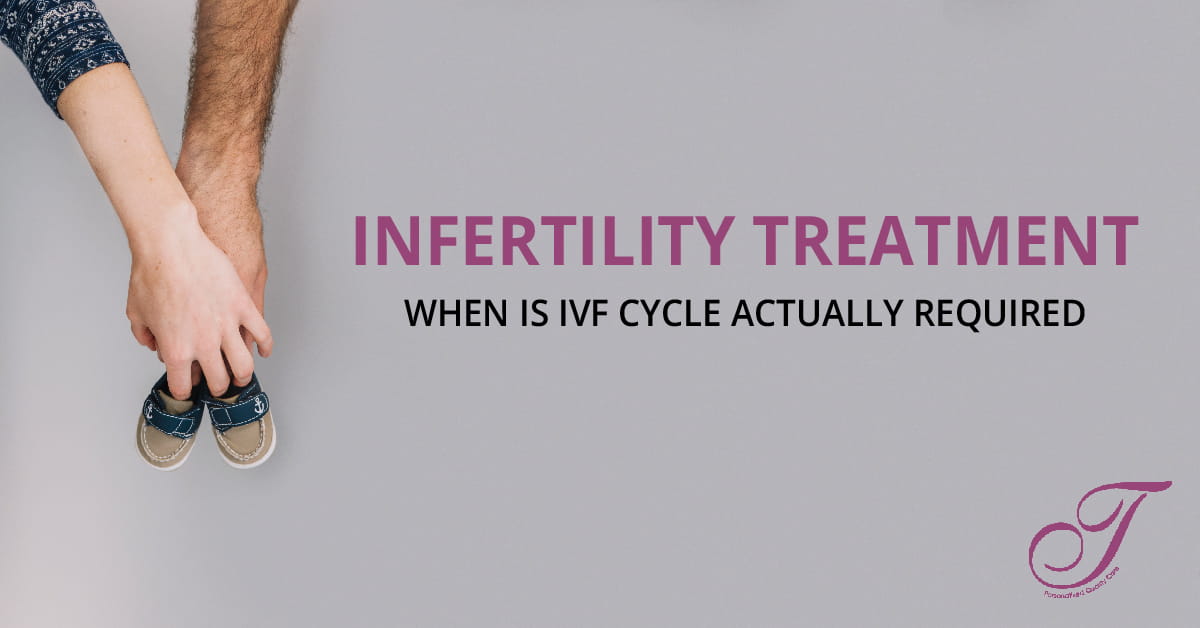Often couples believe that IVF cycle is the only treatment for infertility. However, that is not the case. Dr. Uday Thanawala explains the role of IVF in infertility treatment and when should one pursue an IVF cycle.
A Basic history of Infertility & IVF treatment:
Infertility is defined as the inability to conceive after almost a year of unprotected intercourse. There are many factors causing infertility and IVF is positioned today for certain important indications. 40 years back when the first IVF baby was born, that indication was restricted for tubal infertility.
It means every month the egg is released from the ovary and travels through the Fallopian tube to go into the uterus and there it meets the sperm, resulting in an embryo and pregnancy. If the tubes are blocked or destroyed or somehow not working, then there is no way the egg can meet the sperm. Here IVF comes into play. IVF was first developed to retrieve the egg from the ovary before it ruptures, mixed with the sperm in a Petri dish and the resulting embryo was transferred back into the uterus bypassing the tube completely. This process is called Test Tube baby. It was developed 40 years ago.
In India, the first test tube baby was achieved by Dr. Indrani Hinduja, KEM hospital, Where we both were working together then. I remember, during those days to retrieve the egg we used the procedure of laparoscopy which was a little cumbersome as it involved doing laparoscopy to retrieve all the eggs, process it and mixing it with the sperms.
Things have evolved since then. We don’t use laparoscopy anymore to retrieve the eggs. Today, IVF has become more patient friendly as we use ultrasound to retrieve the eggs. This development has made IVF an easy and accessible process for all patients.
ICSI in IVF treatment
Today we can take out one sperm and inject it into the retrieved egg to fertilise it. This is known as Intracytoplasmic Sperm Injection or ICSI.
The process of ICSI has revolutionised the IVF treatment and has made it more accessible to couples where the sperm count is very low. Male infertility is difficulty to treat. In cases where the sperm count is low IVF has opened a new door which was not treatable otherwise.
IVF Treatment for low sperm count
Anyone having a sperm count of less than one million, we recommend IVF to achieve desired results. Between one and ten million if with other treatment modalities conception hasn’t occurred for about two years or so we resort to IVF.
Indications have changed since the first indication of tubal block. Even for tubal black today, we first try to open the tube by performing hysteroscopic cannulation even though its not possible many a times. Indication of tubal block still remains an indication of IVF.
IVF treatment for infertility due to polycystic ovarian disease (PCOS)
This common cause of infertility is anovulation also called chronic anovulation which means the egg is not formed and not rupturing properly at the right time in many women. 60-70% of these women are suffering from polycystic ovarian disease. In such cases women require drugs to stimulate the ovaries to form the egg and once it ruptures it can meet the sperm naturally resulting in pregnancy.
IVF is usually not the first line of treatment offered as lot of factors come into play. If repeated cycles of ovulation induction have failed or repeated cycles of intrauterine insemination of semen have failed then the patient is suggested the IVF process.
IVF treatment for infertility due to Endometriosis.
Fourth indication which is very common is, Endometriosis. It is a disease of the pelvis where pelvic anatomy is distorted. Typically, these women have lot of pain during periods due to legions growing in the pelvis. Also sometimes there is cyst present in the ovary also known as chocolate cyst, filled with altered blood. This condition is difficult to treat and generally requires surgery. These patients also have a distorted pelvic anatomy and many of them would require treatment for infertility.
IVF comes to the rescue as the treatment of endometriosis along with IVF gives better results. The tricky part with women having a chocolate cyst is whether we should operate first or provide IVF first. Because operating ovary and removing the chocolate cyst some amount of ovarian tissue is removed resulting in less ovarian reserve after the surgery. Today, if a women has a chocolate cyst measuring less than 4 cm, then one should first try IVF and not surgery to achieve pregnancy.
IVF Treatment when infertility is due to low ovarian reserve or Age
IVF has proved to be helpful in women with low ovarian reserve or who have achieved premature menopause ie. eggs have depleted at a very early age. We have seen premature menopause in women as early as 26-27 years olds but generally some women in their early 30’s have very low ovarian reserve.
Even after stimulating the ovaries we do not get the follicle or the eggs out. These are the women we can help with IVF by recruiting a donor for these women. A donor is stimulated. Its eggs are taken out. They undergo IVF with the husbands sperms and the embryo is transported back into the women in premature menopause thus carrying her own baby. IVF has made a huge difference, for women having early menopause and who desire a child, doing it by donor eggs.
IVF for unexplained Infertility
10-20% of the patients have cases known as unexplained infertility. The reason for not able to conceive is not known. Such patients, who are ovulating, have good sperm count, are not able to achieve pregnancy for reasons unknown. IVF is offered to these patients after an adequate length of treatment by other simpler modalities. Techniques which do not involve much cost and the results are better. But, if nothing achieves the pregnancy, as a last resort, IVF is offered. As the success rate with IVF is almost 40% as compared modalities like IUI having a 10-15% success rate.
Unexplained infertility is one of the indications for IVF but one has to weigh the balance of effectiveness against cost and adverse effects of different treatments for this group of patients. There are rarer indications but very useful ones for fertility preservation in women undergoing cancer either by removing the egg and store them or forming embryo or store them. If a women is undergoing treatment from malignancies, another indication is when the uterus is not functioning well or uterus is absent in some cases then we have the effect of surrogacy where again IVF can come to help.
These are the broad indications where IVF has given a good success rate for infertility treatment.
when faced with patients dealing with fertility problems they can be divided into two groups.
First group, belong to patients who definitely require treatment and cannot do without therapy, patients with tubal blocks or aspermia or chronic an ovulation.
The second group, is with patients who have reduced fertility chances but, with time, still have a considerable chance to conceive spontaneously.
One has to evaluate all the factors and then offer a particular line of treatment. It is not only anovulation that we talk about but if anovulation is combined with patients with higher age or low ovarian reserve then the patient is put to IVF cycle at early stage. But, if the patient is young ,then the treatment is still refrained from IVF and simpler methods are offered to the patient which can give results.
Everything is a balance between the cost of treatment, side effects of treatment, convenience of patient as against the success rate per cycle that is achieved. This is how it is decided, which couple would go for IVF and which ones would go for simpler treatment, for better results.
Source : https://thanawalamaternity.com/ivf-required-infertility-treatment/




